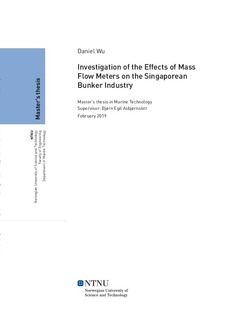| dc.contributor.advisor | Asbjørnslett, Bjørn Egil | |
| dc.contributor.author | Wu, Daniel | |
| dc.date.accessioned | 2019-09-06T14:04:53Z | |
| dc.date.available | 2019-09-06T14:04:53Z | |
| dc.date.issued | 2019 | |
| dc.identifier.uri | http://hdl.handle.net/11250/2613397 | |
| dc.description.abstract | Denne oppgaven undersøker om massestrømmålere har en effekt på bunkersindustrien i Singapore. Drivstoffkvalitetsdata og prisdata blir analysert for å finne endringer som følge av eventuelle effekter av massestrømmålere. Et literaturstudie presenteres for å undersøke relevant forskning innen bunkersindustrien. Det ble oppdaget at ingen tidligere forskning har blitt gjort på effekten av massestrømmålere i Singapore eller
andre havner.
Det blir gitt en beskrivelse av tradisjonelle bunkringsoperasjoner og tlhørende ulemper. Med kunnskap om ulempene ved disse prosedyrene, blir det foreslått noen potensielle effekter fra massestrømmålere. Hypoteser er formulert for å teste om det finnes endringer i dataen som kan relateres til massestrømmålere. Anvendelse av statistisk hypotesetesting på drivstoffkvalitetsdata blir beskrevet. Flere forskjellige statistike tester er undersøkt for egnethet.
De formulerte hypotesene kan oppsumeres i fem punkter. Hypotesene påstår atmassestrømmålerne
har ført til: (1) økning i bunkerprisnivå i Singapore, (2) minskning av prisforskjell mellom Singapore og Hong Kong, (3) endring i fordeling av desimaltall i rapportert drivstoffstetthet, (4) endring i gjennomsnittlig deltadensity, shortlifting benchmark og forekomst av shortlifting, (5) endring i varians av deltadensity parameteren og shorlifting benchmark.
Prisanalyser viste at endringer i bunkringsprisen og prisdifferansen mellom Hong Kong og Singapore fant sted. Disse analysene fant derimot lite grunn til å tilegne prisedringene til en massestrømmålereffekt. Derfor ble hypotese (1) og (2) avvist. Fordelingen av desimaltall i rapportert drivstoffstetthet var uendret, og hypotese (3) ble dermed avvist. For å teste hypotesene i (4) og (5), ble drivstoffkvalitetsdataen fordelt inn i grupper
basert på tetthetsnivå. Dette ble gjort for å redusere avhengighet av en annen effekt som ikke var relatert til massestrømmålere. Dataen ble delt inn i 30 grupper basert på drivstofftetthet, og hypotesetesting ble gjort for hver gruppe. Etter en samlelet evaluering av de forskjellige resultatene fra testene, ble det konkludert at ingen endringer var tydelige. Dette førte til at hypotesene i (4) og (5) ble avvist.
Studiet konkluderer med at introduksjonen av massestrømmålere ikke har påført noen signifikante målbare effekter på pris eller drivstoffkvalitetsdata. Avslutingsvis blir andre måter å måle massestrømmålereffekter foreslått. Disse er som følger: (1) å undersøke varighet av bunkringsoperasjoner, (2) utføre en menighetsmåling blant skipsoperatører for å evaluere Singapore som en bunkringshavn og (3) å studere etterspørselen for bunkerskvanitetsinspeksjoner. | |
| dc.description.abstract | This thesis investigates whether mass flow meters (MFMs) have any effects on the Singaporean marine fuel (bunker) industry. Fuel quality testing data and bunker price data are analyzed for changes caused by potential effects of MFMs. A literature review is presented to assess the research within the bunker industry. It was discovered that no former research had been done on the effects ofMFMs in Singapore or other ports.
The traditional bunker operations and their shortcomings are described. With knowledge about the weaknesses of traditional bunker procedures, we propose some potential effects of the MFMs. Hypotheses are formulated to test if there are any changes captured in the data, and whether these can be related to MFMs. It is presented how statistical hypothesis testing can be applied to the fuel quality data. Several types of statistical tests are assessed for feasibility.
The formulated hypotheses can be summarized into five points. The hypotheses state that mass flow meters have lead to a: (1) bunker price increase in Singapore, (2) decrease in price difference between Singapore andHong Kong, (3) change in distribution of decimal digits in the stated bunker density parameter, (4) change in mean delta density, shortlifting benchmark and occurrence of shortlifting; (5) change in variance of the
delta density parameter and shortlifting benchmark.
Price analysis showed that changes in bunker price and price difference between Hong
Kong and Singapore were present. The analysis found little reason to attribute the price
changes to a potential MFM effect, thus hypothesis (1) and (2) were rejected. The distributions
of decimal digits in the stated bunker density parameter before and after the
use of MFMs were found to be relatively unchanged. The hypothesis (3) was therefore
rejected. The fuel quality testing data was divided into groups based on density levels to test the hypotheses in (4) and (5). This was done to mitigate dependencies from another effect that is not related to MFMs. The data was grouped into 30 bins according to fuel density, and hypothesis testing was conducted on each bin. It was concluded that no clear sign of change was evident, based on an assessment of the collective results of
the tests. Thus, the hypotheses included in (4) and (5) were rejected.
The study concludes that the introduction of MFMs have not caused any significant measurable effect on the price or fuel quality testing data. Finally, other means of identifying the effects of MFMs are proposed. These are: (1) to investigate the duration of bunker operations, (2) to conduct an opinion survey among ship operators to assess Singapore as a bunkering port, and (3) to study whether there has been a fall in demand for bunker quantity surveys. | |
| dc.language | eng | |
| dc.publisher | NTNU | |
| dc.title | Investigation of the Effects of Mass Flow Meters on the Singaporean Bunker Industry | |
| dc.type | Master thesis | |
